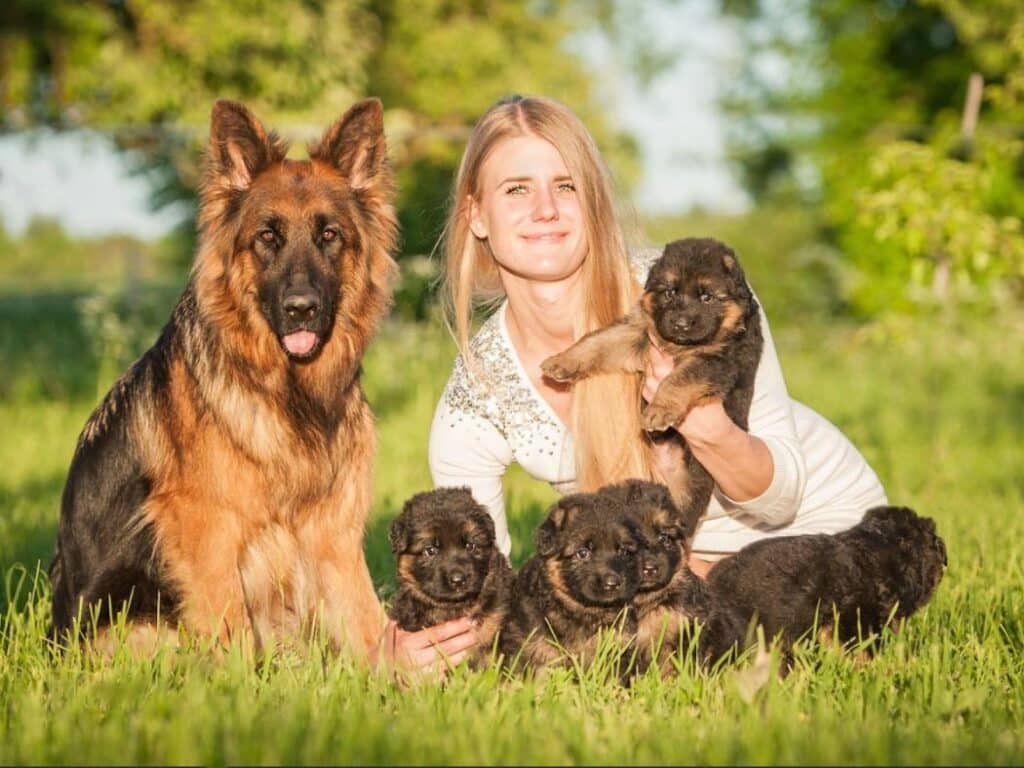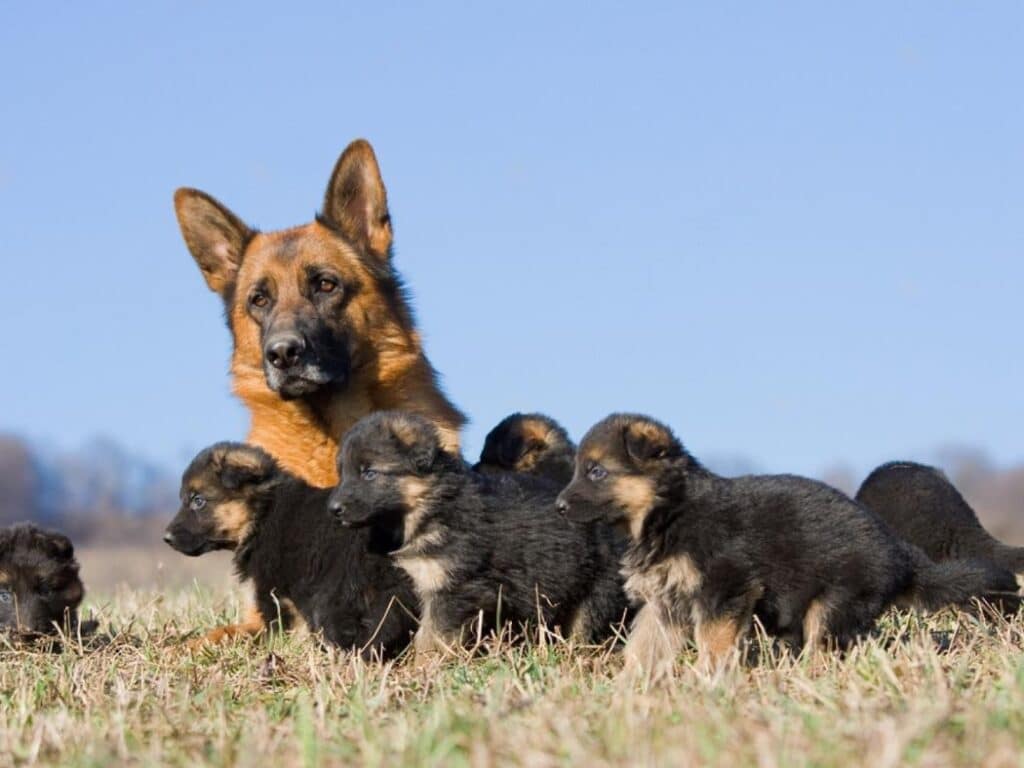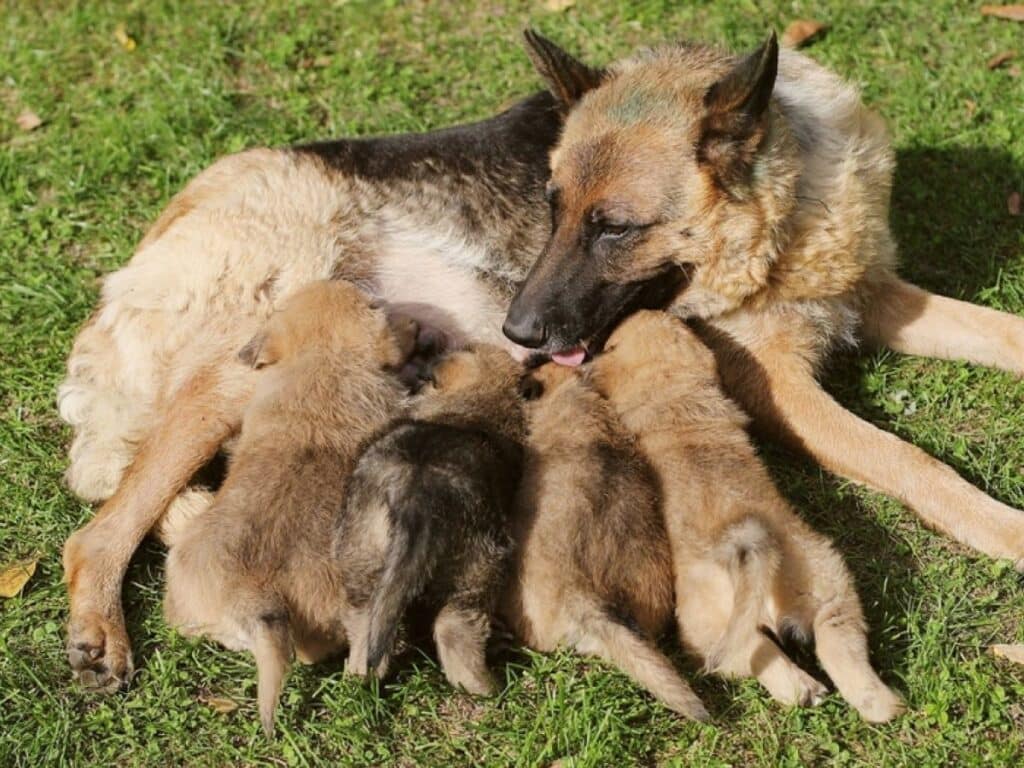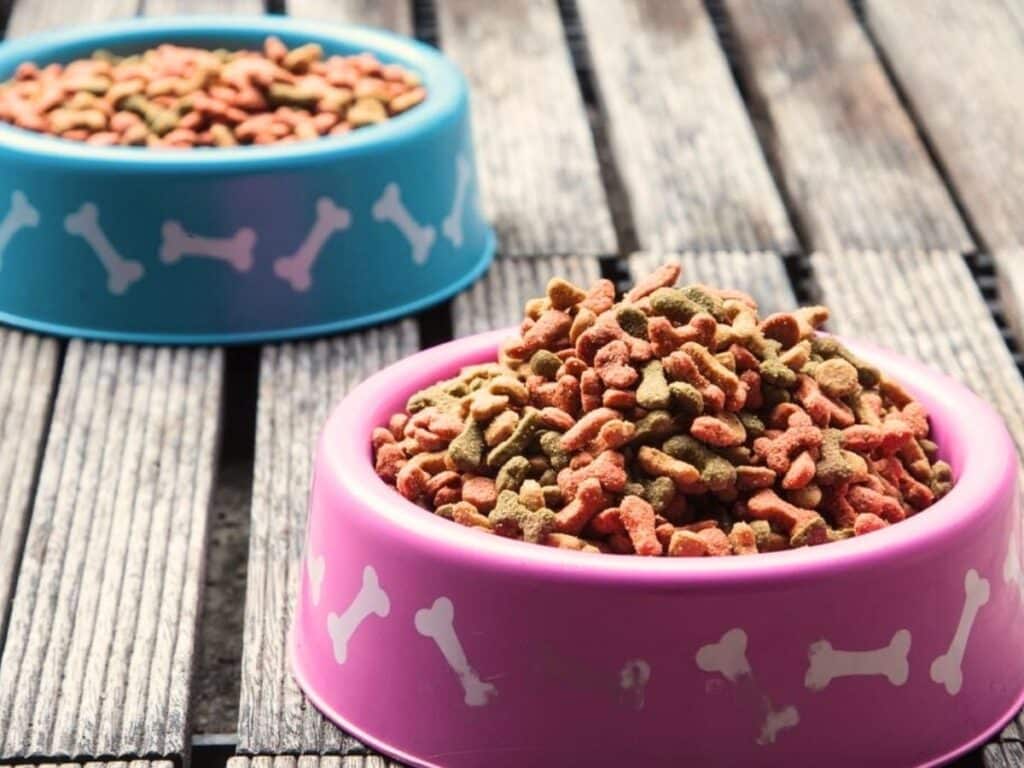Wondering how many puppies can a German Shepherd have? On average, a German Shepherd has 8 puppies in a normal litter. However, they may also have litters with as few as 1 or 2 puppies or as many as 15.
Various factors can influence the litter size, including genetics, the age of the female, health, nutrition, and breeding practices. A female GSD’s first litter is typically smaller than average.
Responsible breeding, proper prenatal care, and attention to the overall well-being of the mother can contribute to healthy litters.
How Many Puppies Can a German Shepherd Have At Once?
According to the American Kennel Club, the average German Shepherd puppy litter can have anywhere from 1 to 15 puppies in a normal litter. while most female German Shepherds give birth to an average of 8 puppies. This is a reliable range, especially if you have a purebred German Shepherd.
It’s crucial to note that this approximation can vary between different GSDs. This is mainly because of factors that can affect litter size.
As a large dog breed, GSDs take up to 63 days to give birth to a litter of puppies. During this time, they need lots of love and attention to ensure they have a healthy pregnancy.

How Many Puppies Can a German Shepherd Have in the First Litter?
From my experience, most first litters are indeed around 6-8 in number. A bitch’s first litter may be smaller than consecutive litters. In most cases I’ve experienced, and seen, the second litter tends to be the largest.
Your veterinarian can help you find out exactly how many puppies there are inside your GSD’s uterus.
They can take X-rays of the pregnant female and count the skeletons of pups in her belly. This is an acceptable way to determine litter size in dogs.
Although it’s not sure-fire” because it’s easy to miss one of the puppies” this process gives you a good idea of your German Shepherd’s litter size.
You have to wait until six weeks of pregnancy for the puppies’ skeletal system to develop.
Ultrasound scans and abdominal palpation are other ways to estimate German Shepherd litter size. Ultrasounds can be taken around 20-22 days to confirm pregnancy.
It is also important to note that male and female ratios can go in either direction. It is also possible to have a litter with all one gender. A friend of mine recently told me that her bitch delivered an all-female litter, all eight of them. It is very unlikely, but it does happen.

Factors That Affect the German Shepherd Litter Size
While we cannot breed dogs to give birth to a specific number of offspring, several factors can affect your German Shepherd’s litter size.
1. The Health of the Female
Healthy dams will give birth to a larger litter compared to a dog that is not healthy. Healthy canines can carry a pregnancy to term and lower the likelihood of miscarrying the pup.
On the other side, unhealthy dogs may have trouble carrying the pregnancy and, in the worst situation, may lose some or all the puppies.
If your German Shepherd is obese or not given enough exercise, this too can affect the litter.
The male GSD’s age also affects the litter size. But the influence is much less than the female’s age.
As a male gets older, his sperm count and quality decrease. He will produce larger litters under the age of five.
2. Age of the Female
The most fertile years for female German Shepherds are between 2 to 5 years. As she continues to advance in age, her litter size gets smaller and smaller. (Source)
Normally, a German Shepherd dam gives birth to her first litter at around 2 years. After that, she continues having more puppies, but in the 5th year, the number declines. It’s important to note when she comes into her heat cycle and breeds her at the right time.
The best time to breed a German Shepherd is at 2 years old when she’s mature enough to handle pregnancy.
Most dogs have their first heat cycle at 6 months, but that’s too young for breeding. The stresses of pregnancy might be too much for a young dog of 6 months to handle.
So, just like the American Kennel Association recommends, be patient and wait for her 3rd cycle. Her reproductive organs are well developed by this time, and her body can handle her first pregnancy.
RELATED: Neuter or Spay Your German Shepherd: Timing, Pros & Cons
3. The Size of the Female
According to this study, the litter size is also affected by the dog’s size. German Shepherds are larger dogs, and they have more puppies than smaller breeds.
This trend is seen even within the same breed. A GSD weighing 50 pounds may only produce five or six babies, while a 70-pound dam may give birth to a litter of ten puppies or more.
Larger females tend to have more puppies than smaller ones due to their larger uterus size and capacity.

4. Nutrition
Proper nutrition plays a crucial role in influencing the litter size of a pregnant German Shepherd. During pregnancy, the mother’s body undergoes increased energy demands and nutrient requirements to support the growth and development of the growing puppies.
Essential nutrients such as high-quality proteins, vitamins, and minerals contribute to the formation of healthy tissues, organs, and bones in the fetuses.
Feeding a low-carb diet during pregnancy leads to increased fetal death and stillbirths. Consult your vet and make sure her diet includes enough vitamins, amino acids, minerals, omega-3 acids, antioxidants, and dietary fiber.
As the mother nears the last three weeks of pregnancy, her dietary needs will increase significantly. This is because the embryonic puppies gain 75 percent of their body weight during this period.
Depending on the litter size, she may need one and a half to two times her typical requirement for these few weeks.
5. Gene Pool Diversity
Breeding two dogs from diverse genetic backgrounds results in bigger litters. Similarly, the smaller the gene pool is, the fewer puppies your GSD will have.
The gene pool is smaller when closely related dogs (brothers and sisters, fathers and daughters, etc.) are bred together. The more dogs are bred from the same line, the smaller the litter will be.
This is called inbreeding.
Inbreeding poses a lot of health risks for puppies. But it also impacts the number of puppies that your GSD can have.
Puppies born due to inbreeding can suffer from poor immune function and overall poor health. Inbreeding will continue to result in smaller puppy litter, so it’s better to avoid it.
Other Factors to Consider
Apart from the things we discussed, litter size is also affected by:
- Method of breeding: Dogs that have been artificially inseminated have fewer litters than dams that got pregnant naturally. The reason for this is that during collection in the artificial insemination process, a lot of sperm dies before fertilization.
- Season: Usually, if a GSD gives birth in spring, she produces more puppies. But if the breeding takes place in summer, the litter size is smaller.
- Mating frequency: Litter size is smaller if the female is bred only once. So it’s recommended to mate the GSDs every other day until the female refuses to mate.
Check out this video of a German Shepherd giving birth to 9 puppies…

Is It Possible to Increase the German Shepherd Litter Size?
While litter size is mostly out of our control, optimal conditions can increase how many puppies a German Shepherd can have.
- Ensure Good Health: Both the male and female should be in good health before breeding. Regular veterinary check-ups, a balanced diet, and proper exercise contribute to overall well-being.
- Genetic Selection: Choose breeding pairs with good genetics, free from hereditary diseases or conditions that could impact the litter’s health.
- Timing of Breeding: Plan the breeding during the female’s fertile period, which typically occurs during her heat cycle. Working with a veterinarian can help pinpoint the optimal time for mating.
- Proper Nutrition: Provide a well-balanced and nutritionally rich diet during the pregnancy to support the health of the mother and the developing puppies.
A healthy living environment is also essential for your dog. They need to feel love and affection from the day they’re born.
Such an environment means your dog won’t be stressed and can enjoy her pregnancy.

How often do German Shepherds produce puppies?
Female dogs, including German Shepherds, typically experience estrous cycles, commonly referred to as heat cycles, approximately every six months.
Considering this, a female German Shepherd could potentially have two litters per year if she is bred during both of her heat cycles.
However, many breeders and veterinarians advise against breeding continuously. They contend that it’s hard on the mother’s body and decreases the litter size.
Accordingly, they allow their female GSD to breed every other heat cycle, which means the mother will give birth to one litter per year.
How many puppies German Shepherds can have in their lifetime?
On average, a healthy female German Shepherd can have one to two litters per year. Litter sizes can vary, but it’s common for German Shepherds to have around 6 to 8 puppies per litter.
If a dog has a longer breeding span, say from 2 to 8 years of age, and she has two litters per year with an average of 7 puppies per litter, the total number of puppies over her reproductive years could be approximately 84 (2 litters per year * 7 puppies per litter * 6 years).
Closing Thoughts
GSDs usually have six to eight puppies per litter, and a healthy and well-cared-for mother is more likely to have a larger litter. So, whether you’re a breeder or an owner, providing the best care for your German Shepherd is crucial for ensuring the health and size of their litters. Ensure the potential mate is also healthy and at the right age. However, no matter the litter size, each puppy will be a bundle of pure joy!




